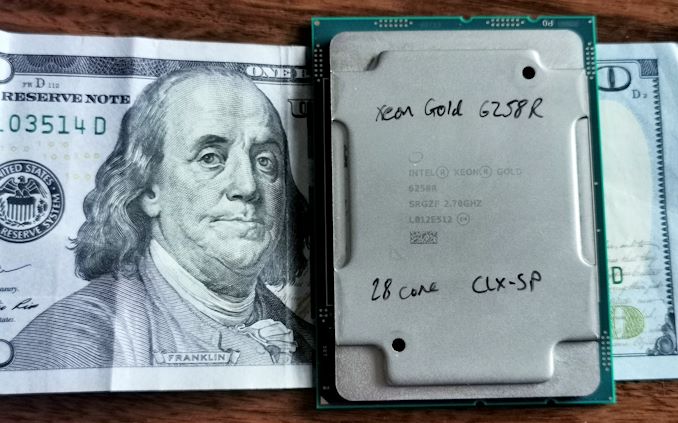How to Save $6000 on a 28-core Flagship Intel Xeon: Platinum 8280 vs Gold 6258R
by Dr. Ian Cutress on August 7, 2020 8:00 AM ESTDoes the 6258R Make Sense for Intel?
For this test, I wanted to compare the difference between Intel’s Xeon Platinum 8280 and Intel’s Xeon Gold 6258R. These processors are practically identical on paper for any regular 1P or 2P server, offering up 28 cores at 2.7-4.0 GHz, however the Gold 6258R has a list price that saves over $6000 compared to the Platinum 8280.
As per our regular testing procedure, I put both CPUs in our 1P LGA3647 test system and ran through our performance benchmarks. We also took power measurements, latency measurements, and idle-to-turbo measurements. Everything came out the same. Without the name of the CPU on the heatspreader, or a different CPU string when probed, no-one would be able to tell the difference in a 1P or 2P environment.
So if anyone is thinking of deploying Intel’s high-end Xeon Platinum 8280s in anything less than a eight-socket system, don’t bother. Save a few grand per CPU and gain the plaudits of your boss – unless they start asking questions about why the infrastructure doesn’t have the latest ‘Xeon Plutonium’ things they’re heard about.
Jokes aside, the pragmatic question to ask is:
Has Intel shot itself in the foot with the 6258R?
Intel often repeats (as does AMD) that the majority of its server customers exist in that 1P and 2P spectrum. An offering like the 6258R replaces the 8280 in all aspects for that, giving Intel an effective performance-per-dollar improvement of 2.5x, while at the same time lowering its selling price - when we compare the prices, Intel stands to lose $6000 per processor sold.
However, Intel launched the 8280 in April 2019 as the flagship – the 6258R only came out in February 2020. Anyone who wanted the perfromance of the 8280 in that time frame already purchased one. At the same time, a few months later, the company has launched its 3rd Generation Xeon Scalable platform, known as Cooper Lake. We’ve covered Cooper Lake in detail, but the short information is that it is an OEM platform designed for 4-socket and 8-socket servers. Any customer who needs servers that large are now going to look at Cooper Lake as the leading product, meanwhile the 1-socket and 2-socket customers are still on the Cascade Refresh options.
At this point, the 8280 is a dead product for Intel.
- Users who want the 4-8 socket compatibility and performance can now get the 8380H/HL.
- Users who want the 1-2 socket compatibility and performance will go for the 6258R.
If you’re wondering where the 6258R stacks up against AMD, we’re in the process of re-testing the parts we have on hand as we go through our regression testing. The EPYC 7542 is probably the best comparison point (32C, 2.9-3.4 GHz, 225W, $3400), however we’ll have to look into getting one of those.











81 Comments
View All Comments
Krysto - Friday, August 7, 2020 - link
Buy the 32-core AMD Epyc?Tomatotech - Friday, August 7, 2020 - link
Nice article. I note from the CPU-Z screenshot on the first page one of the few differences is the older chip has a core speed of 997mhz with a 10x multiplier, and the the new chip is at 1097mhz with a 11x multiplier.That seems worth commenting on, but it wasn’t discussed in the article?
coschizza - Friday, August 7, 2020 - link
Si the same from 10 to 40Slash3 - Thursday, August 13, 2020 - link
That's just a byproduct of an idling desktop. They'll float at low multipliers until a load is presented, and the reported frequency in each shot is, in this case, irrelevant.Spunjji - Friday, August 7, 2020 - link
My biggest take-home from this:Intel's CPU naming scheme is worse than ever and needs to die in a fire.
Seriously - here we have two near-identical CPUs, the sole difference being the extent of their multi-socket capability, and the only part of their name they have in common is "Xeon".
shabby - Friday, August 7, 2020 - link
Maybe its me but this just seems like a pointless article.romrunning - Friday, August 7, 2020 - link
Would have been nice to see AMD's EPYC 7742 processor results with those two Xeons.eastcoast_pete - Friday, August 7, 2020 - link
This is more a comment on a number of other comments here: When it comes to mission-critical servers, reliability and availability is often if not always the # 1 criterion. Not sheer processing power, or even efficiency or price. That is where AMD must invest and show commitment, and to the whole package: CPU, chip set, software support. Once the perception on Intel with Xeon always being the safer choice is gone, AMD will shift a lot more EPYCs and related products.Oxford Guy - Friday, August 7, 2020 - link
I’m glad this article made it clear that AMD doesn’t exist.I would have thought that EPYC would have been presented in the benchmarks to show the alternative to Intel competing with itself but what do so know?
Tomatotech - Saturday, August 8, 2020 - link
Guess who didn’t read the article? Especially the last paragraph?